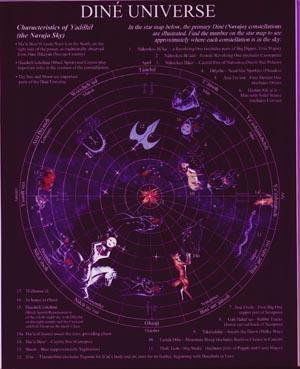by Sophie Ell, Hillerman Digital Fellow
Originally published on Celebrating New Mexico Statehood, 08/19/2016
“Hillerman Country” has long been a familiar term among the digital portal’s fellows, New Mexico residents, and fans all over the world. It evokes the canyons and mesas of the Navajo Reservation and the northwestern New Mexico and northeastern Arizona high desert landscapes, but anyone who has read a Hillerman mystery knows that when the sun goes down on the enchanted terrain a different kind of scenery emerges, one that requires a raising of the gaze upwards. The night skies of Hillerman Country paint pictures of lingering sunsets, waxing and waning moons, and moving star constellations, which not only enhances the unique Southwestern atmosphere that has become Hillerman’s literary hallmark, but also provides a gateway into the rich celestial realms of Native American lore.
Practically every ancient culture in every continent around the globe has studied the night sky and integrated celestial symbolism into a system of beliefs, seasonal ceremonies, and elaborate mythologies. The prehistoric science of astronomy was a way to tell time, predict periodic changes, prepare for planting, harvesting, hunting, or migrating, and create order and meaning in a world with no clocks or calendars, a world that was profoundly regulated solely by the forces of nature.
In the Navajo tradition, the stars, the sun, and the moon served, first and foremost, as timekeepers and seasonal markers. The bear constellation (shash, in Navajo), for example, which corresponds with the Greek Sagittarius, signals the coming of spring. Like a bear’s nose emerging out of its den after a long winter slumber, the tip of the constellation begins to appear in the predawn hours of the night sky in early spring. To the Navajo, the gradual rising of the bear over the horizon indicated the coming of rain, wind, warmer air, the blooming of certain native plants, and the approaching season for planting crops.
But to the Navajo, stars are also representatives of spiritual beings and supernatural phenomena, with much of it relating to origin myths. The Coyote Star, for instance, which does not hold much practical value, has important symbolic significance. This star, which in Western astronomy appears as part of the Argo Navis constellation, is only visible in the southern sky for a few short weeks each year. According to Navajo legend, when the stars were being placed in the sky at the beginning of time, Coyote, the trickster, got impatient with the process, grabbed the pouch containing the crystal star seeds, and tossed the seeds onto the dark firmaments. This represents the chaos that exists in the world, and the disruption of the originally envisioned order.
Star constellations appear in Navajo sand paintings, are referred to in healing ceremonies and blessing rituals, and play an important role in creating cosmological meaning. For those of us who live in big Southwest cities such as Albuquerque, the night sky is often a forgotten, hidden part of our urban landscape. But not too far from here, in the mesas and canyons that are still well-shielded from growing light pollution, the night sky of Hillerman Country is as spectacular as ever, providing a humbling reminder that, in the big scheme of things, we are but a small part of a great and mysterious universe. They are also an invitation to appreciate and cherish the living knowledge and wisdom of our Navajo neighbors, who have resided here much longer than we have.
References
Maryboy, Nancy C., and David Begay. 2010. Sharing the Skies: Navajo Astronomy. Tucson, AZ: Rio Nuevo Publishers.
Munson, Gregory E., Todd W. Bostwick, and Tony Hull. 2014. Astronomy and Ceremony in the Prehistoric Southwest, Revisited: Collaborations in Cultural Astronomy.

